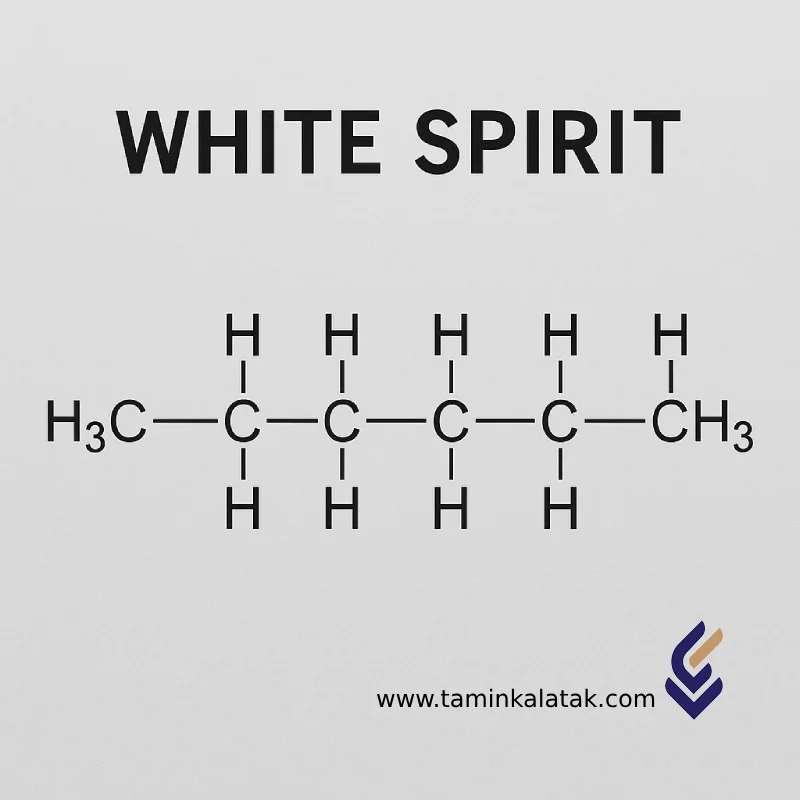White Spirit
White Spirit, also known as industrial kerosene, mineral spirits, or light naphtha, is a light aliphatic and aromatic hydrocarbon mixture obtained through fractional distillation of crude oil. It is a colorless, transparent, volatile, and flammable liquid, widely used as a solvent in various industries such as paints and coatings, degreasing, automotive, and woodworking.
Chemical Structure of White Spirit
-
General Formula: A mixture of n-alkanes, iso-alkanes, cycloalkanes, and a small proportion of aromatic hydrocarbons such as toluene and xylene
-
Chemical Composition: Primarily composed of C₇–C₁₂ hydrocarbons, depending on the grade
-
Molecular Structure: A combination of linear and branched saturated hydrocarbon chains with a minor aromatic fraction
-
CAS Number: 8052-41-3 (for White Spirit Type 1)
Physical and Chemical Properties
| Property | Description |
|---|---|
| Physical State | Colorless, clear, and volatile liquid |
| Odor | Mild petroleum-like odor |
| Boiling Point | 130–230 °C |
| Flash Point | 38–55 °C (depending on the type) |
| Viscosity (at 40 °C) | Approximately 1–2 cSt |
| Refractive Index | 1.43–1.46 |
| Water Solubility | Practically insoluble |
| Log P (Partition Coefficient) | Around 3.5 – indicating lipophilicity and high affinity for organic phases |
Applications of White Spirit
Paints and Thinners Industry
-
Solvent for oil-based, alkyd, and resin paints
-
Viscosity regulator in the production of thinners and varnishes
-
Used in solvent-based coatings to ensure uniform film formation and drying
Degreasing and Cleaning
-
Removes grease and oils from industrial machinery and tools
-
Cleans metal parts prior to painting or coating
-
Applied in dry degreasing processes in metalworking and fabrication lines
Printing and Automotive Industries
-
Solvent for petroleum-based printing inks (e.g., flexographic and gravure inks)
-
Used for cleaning mechanical parts, engines, and tools
Wood and Furniture Industry
-
Diluent for wood varnishes, polishes, and waxes
-
Removes excess oils and grease before painting or finishing
-
Used in final polishing to improve surface smoothness and uniformity
Advantages of White Spirit
-
High solvency power for oils, resins, and oil-based paints
-
Moderate volatility, allowing optimal drying without overly fast evaporation
-
Safer alternative compared to harsher solvents such as acetone or xylene, especially on wooden surfaces
-
Economical and widely available for industrial use
-
Stable under standard storage and handling conditions
Disadvantages of White Spirit
-
Highly flammable, requiring strict safety precautions in enclosed spaces
-
Irritating to eyes and skin upon direct contact
-
Inhalation of vapors may cause dizziness, nausea, or headaches
-
Unpleasant odor at high concentrations
-
Incompatible with strong oxidizing agents such as permanganates or peroxides
Safety and Storage Guidelines
- According to GHS Classification, White Spirit is labeled with:
- H226: Flammable liquid and vapor
- H304: May be fatal if swallowed and enters airways
- H336: May cause drowsiness or dizziness
- Personal Protective Equipment (PPE):
- Nitrile gloves, half-face respirator with organic vapor filters, and safety goggles are required.
- Ventilation: Adequate ventilation is essential (preferably local exhaust or mechanical ventilation).
- Storage: Keep in tightly sealed, solvent-resistant containers, away from heat, open flames, and direct sunlight.
- Transportation: Classified under UN 1300 with flammable liquid labeling required on all containers.
White Spirit
| Products | Grade | Vapor pressure | Solubility in water | Melting point | Density (at 20°C) | Physical appearance | CAS number | فرمول شیمیایی |
|---|---|---|---|---|---|---|---|---|
| White Spirit (also known as Mineral Spirits) | Type 1: Dearomatized (less than 1% aromatics) Type 2 & 3: Aromatic | 0.3 – 1.0 kPa at 20°C | Insoluble (practically zero) | Below -30°C (depending on exact composition; usually below zero) | 0.76 – 0.82 g/cm³ | Clear, colorless liquid with a mild petroleum odor. | 8052-41-3 (Type 1) | A mixture of C₇ to C₁₂ aliphatic hydrocarbons and some aromatics. |







